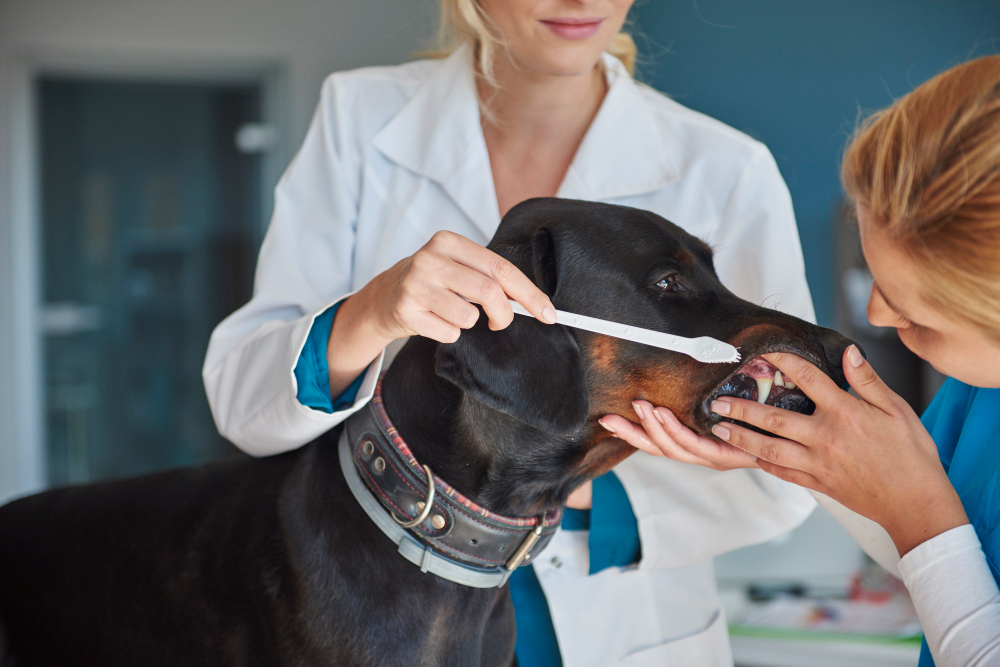You’ve undoubtedly heard about the strength of canine teeth, but is this true? Made to hold and tear prey, a dog’s teeth are excellent weapons. Combined with a lot of strength of the muscles of the face, from a tiny chihuahua or imposing rottweiler, you’ve probably been afraid of a dog when you see them with their tense face showing their pointed teeth.
Are Dog Teeth Strong?
You already know that dogs have a powerful bite. Kengal dogs, for example, have the most substantial bite among all dog breeds at around 746 Psi (Pound force per Square Inch (PSI). are teeth also strong and resistant? To answer this question, we need to understand how the oral anatomy and the structure of a dog’s teeth work.
Adult dogs have 42 teeth, 12 incisors, four canines, 16 premolars, and ten molars. Making a brief comparison, we adult humans have 32 teeth. That is, dogs have ten more teeth. Each category of tooth serves a different function. The incisor teeth are small and short, are at the front of the mouth, pull meat from bones, and help remove dirt from the dog’s fur. Canines teeth are the biggest and scariest. They have an elongated and pointed appearance and serve to hold and tear food. When we think of animal teeth, canines are the first that come to mind. On the other hand, the premolars and molars serve to chew and grind food, having a flatter surface.
The structure of teeth is the same as compared to humans, and it has three hard tissues: cementum, dentin, and enamel. The cementum is the tissue responsible for fixing the roots of the teeth. Dentin absorbs impacts caused by food or wears and encompasses nerve endings, and blood vessels, the roots of canine teeth are longer and more resistant. And finally, covering the teeth is the outer layer of enamel, the most resistant tissue in the body that aims to protect the teeth against friction with food and bones.
Are Dog Teeth Stronger Than Human Teeth?
But after all, what characterizes an animal’s tooth to be stronger than others?
The layer responsible for making teeth stronger and stronger is enamel. However, in dogs, the enamel layer is thinner, leaving the teeth more exposed to damage, making them weaker than human teeth. Studies indicate that the enamel layer of canine teeth is up to 6 times thinner compared to the enamel layer that covers our teeth. In addition, some dogs can be affected by a comorbidity called enamel hypoplasia, which leads to incomplete or defective formation of tooth enamel, leading to irregularities of the tooth surface and a propensity to accidental damage. That is, it is more likely that a dog with this condition breaks a tooth when gnawing a bone.
You certainly thought dogs’ teeth were tougher than ours, didn’t you? We still have more surprising news about canine teeth vs. humans. Despite what many think, dogs are not born with ready teeth. Just as human children have milk teeth, puppies also have them. At around 20 days of age, these teeth begin to appear. There are only 28 temporary teeth, small, thin, and pointed. You have certainly been bitten by a puppy and felt in your skin that despite being small, these bites hurt a lot and have a great potential to leave deep wounds on your skin. The complete change to permanent teeth takes place around eight months. This change happens very quickly and often goes unnoticed by dog owners. To avoid dental trauma in puppies is essential to take them for a walk and spend energy to prevent them from gnawing on inappropriate objects such as tables and shoes. Also, it is vital to provide chew toys, such as teethers designed especially for puppies. At this stage, puppies are often very agitated, and accidents happen frequently. If you are playing with your friend and you notice that he is toothless, do not worry many times puppies end up swallowing their teeth and do not even realize it is a natural process because all the milk teeth must fall out so that there is space for permanent teeth. However, in cases of excessive bleeding, take him to the vet for evaluation to avoid infection or abscess formation.
How much force does it take to break a dog’s tooth? Do dog teeth break easily?
A study carried out in Europe proved that the jaws of dogs are so strong that they can break all their teeth when chewing on rigid objects. The oral musculature, unlike dentition, is powerful, which can lead to oral injuries and tooth breakage. It doesn’t take a lot of force to fracture a dog’s tooth. Food and products that are too hard or unsuitable for dogs used as toys can easily damage the tooth structure. Another study in Pennsylvania found that 27% of dogs fracture their teeth, so be aware of everything your dog puts in his mouth and avoid accidents! In the event of an accident, take it to the veterinary dentist immediately, as in most cases, it is necessary to extract the tooth to avoid complications.
Are Dog’s Teeth Stronger Than Bone?
Do you provide your dog with boiled bones? Stop immediately! Cooked bones should never be fed to dogs, as during cooking, they become brittle and can cause severe damage to your dog’s health, such as tooth fractures to gastrointestinal obstructions. Always try to provide raw recreational bones with appropriate prophylactic treatment.
Some accidents can happen without you realizing it. In these cases, it is crucial to be aware of your dog’s signs, such as loss of appetite, swelling in the muzzle region, apathy, pain, bleeding, and difficulty chewing. Attention, do not medicate your dog on your own. Look for help from a specialist!
Check out five tips to identify dental problems:
- Inspect your dog’s mouth regularly: observe the entire structure of the mouth, and look for signs of tooth wear, plaque, and dental calculus. Take the opportunity and look at the gums and see if the coloring is regular and if there is no swelling. The inspection will make it easier to identify problems and resolve them faster, keeping your teeth healthy.
- Look for signs of infection: if you notice discharge, bad breath, and bleeding or swollen gums, take him to the vet immediately.
- Inspect the outside of the mouth: an infection does not always appear with clinical signs. It is important to analyze for swollen regions and local fever.
- Observe the clinical signs: infections usually cause severe local pain, which results in excessive salivation, fear, anguish, and lack of appetite. Watch out for the signs!
- Please take it to the vet specialist in dentistry annually!
To maintain good oral health and strengthen teeth, cleaning it with daily brushing with products suitable for dogs and introducing snacks suitable for oral care is essential. This attention to oral health will maintain proper tooth structure, and tooth enamel will not be worn out, making teeth more resistant. I understand that I need to brush my dog’s teeth, but it is furious and doesn’t allow it. What do I do? If this is your case, check out the following tips:
- Get the dog used to the new routine. Start slowly, just passing the brush through a few teeth, and increase the time and region each day until the dog gets used to the new routine;
- Praise him after completion and offer rewards as a treat;
- Use toothpaste made for dogs with a pleasant flavor, and you can find it in the market with meat, fruit, and mint flavor. Attention, never use human toothpaste, as it contains toxic substances for dogs!
- Use brushes with soft bristles to avoid injuries;
Now that you know that taking care of dogs’ oral health is essential to keeping their teeth strong and healthy, let’s put it into practice!














